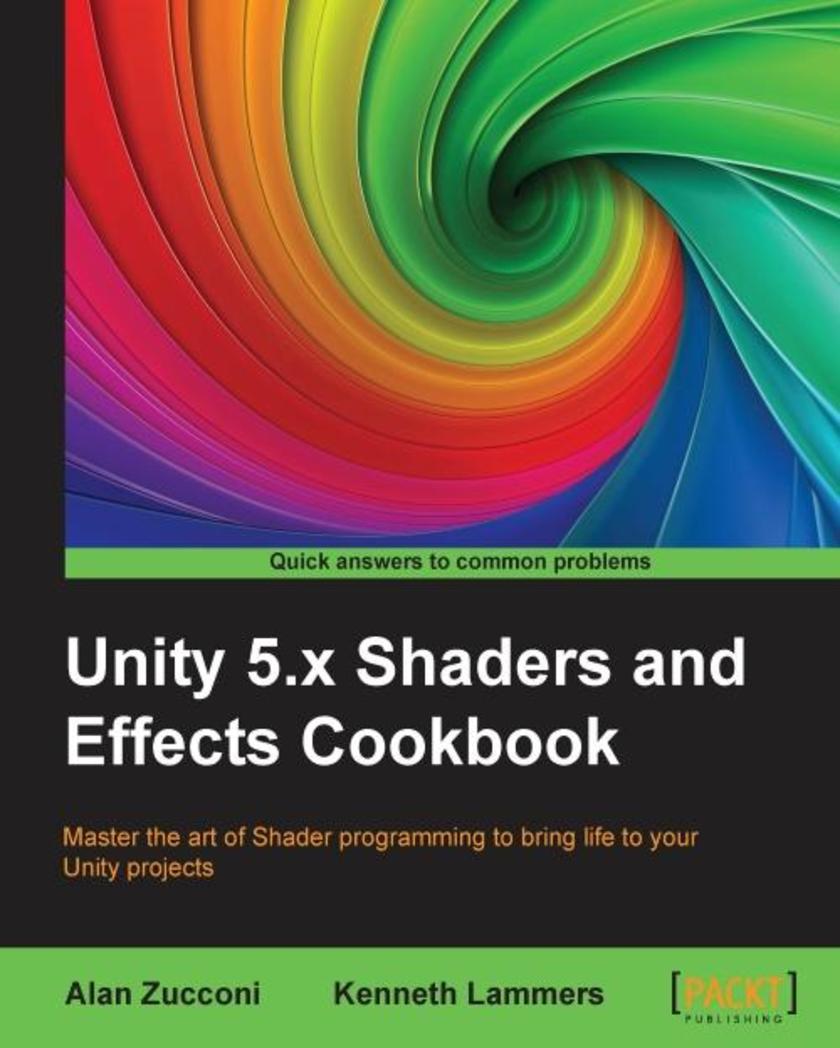
Unity 5.x Shaders and Effects Cookbook
¥90.46
Master the art of Shader programming to bring life to your Unity projectsAbout This BookThis book will help you master the technique of physically based shading in Unity 5 to add realism to your game quickly through precise recipesFrom an eminent author, this book offers you the fine technicalities of professional post-processing effects for stunning resultsThis book will help you master Shader programming through easy-to-follow examples to create stunning visual effects that can be used in 3D games and high quality graphics.Who This Book Is ForUnity Effects and Shader Cookbook is written for developers who want to create their first Shaders in Unity 5 or wish to take their game to a whole new level by adding professional post-processing effects. A solid understanding of Unity is required.What You Will LearnUnderstand physically based rendering to fit the aesthetic of your gameEnter the world of post-processing effects to make your game look visually stunningAdd life to your materials, complementing Shader programming with interactive *sDesign efficient Shaders for mobile platforms without sacrificing their realismUse state-of-the-art techniques such as volumetric explosions and fur shadingBuild your knowledge by understanding how Shader models have evolved and how you can create your ownDiscover what goes into the structure of Shaders and why lighting works the way it doesMaster the math and algorithms behind the most used lighting modelsIn DetailSince their introduction to Unity, Shaders have been notoriously difficult to understand and implement in games: complex mathematics have always stood in the way of creating your own Shaders and attaining that level of realism you crave. With Shaders, you can transform your game into a highly polished, refined product with Unity’s post-processing effects.Unity Shaders and Effects Cookbook is the first of its kind to bring you the secrets of creating Shaders for Unity3D—guiding you through the process of understanding vectors, how lighting is constructed with them, and also how textures are used to create complex effects without the heavy math.We’ll start with essential lighting and finishing up by creating stunning screen Effects just like those in high quality 3D and mobile games. You’ll discover techniques including normal mapping, image-based lighting, and how to animate your models inside a Shader. We’ll explore the secrets behind some of the most powerful techniques, such as physically based rendering! With Unity Shaders and Effects Cookbook, what seems like a dark art today will be second nature by tomorrow.Style and approachThe recipes in this book contain step-by-step instructions, complemented by screenshots and code, and real-world examples.
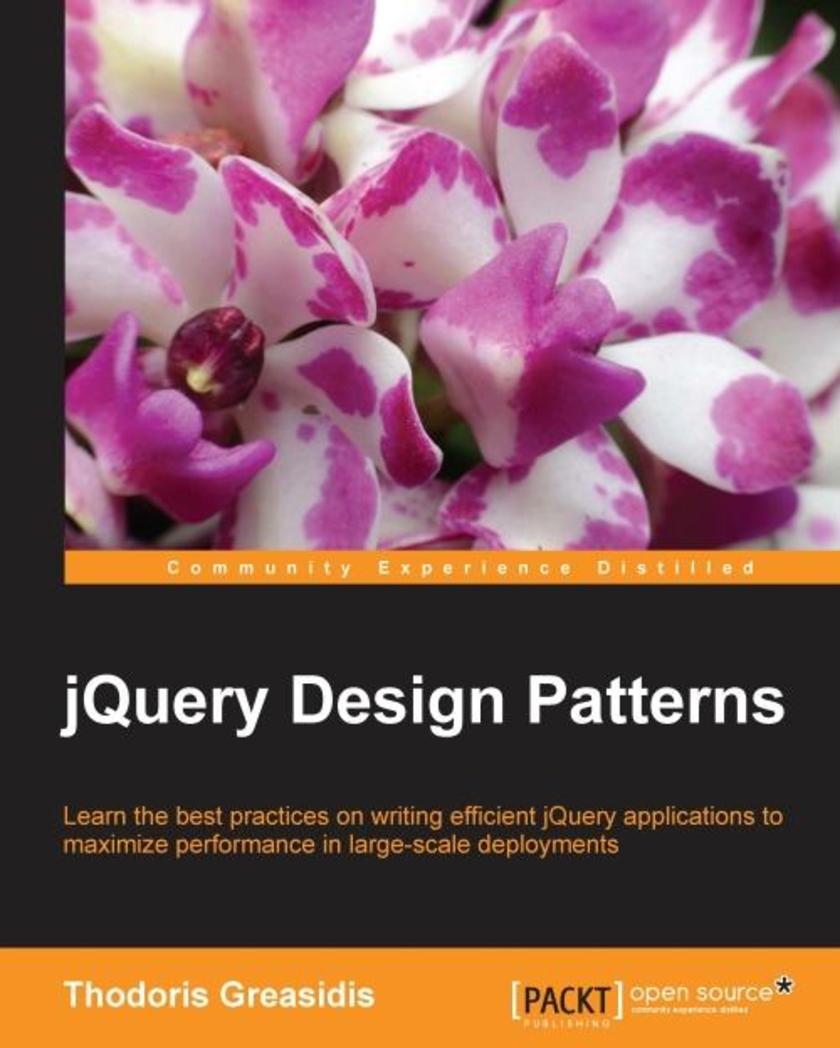
jQuery Design Patterns
¥71.93
Learn the best practices on writing efficient jQuery applications to maximize performance in large-scale deploymentsAbout This BookLearn about the observer pattern and the deferred observer pattern, two of the most popular design patterns that handle custom eventsAdvance your jQuery skills by learning about patterns such as divide and conquer, facade, and builder and factory to handle complex resultsThis step-by-step guide to applying micro-patterns and optimizing jQuery applications will help you get the best performance in a production environmentWho This Book Is ForThis book is for existing jQuery Developers or new developers who want to get an understanding of the “correct way” to build jQuery applications, using best practices and industry standard patterns.What You Will LearnRespond to user actionsAchieve greater flexibility and code decouplingHave a central point for emitting and receiving application level eventsStructure the application into small independent modulesAbstract complex APIsIsolate the procedure of generating complex parts of the applicationEfficiently orchestrate asynchronous procedures using jQuery Deferred and PromisesUtilize the most widely-used client-side templating libraries for more complex use casesIn DetailjQuery is a feature-rich JavaScript library that makes HTML document traversal and manipulation, event handling, animation, and Ajax much simpler with an easy-to-use API that works across a variety of browsers. With a combination of versatility and extensibility, jQuery has changed the way that millions of people write JavaScript.jQuery solves the problems of DOM manipulation, event detection, AJAX calls, element selection and document queries, element attribute and data management, as well as object management utilities. This book addresses these problems and shows you how to make the best of jQuery through the various design patterns available.The book starts off with a refresher to jQuery and will then take you through the different design patterns such as facade, observer, publisher/subscriber, and so on. We will also go into client-side templating techniques and libraries, as well as some plugin development patterns. Finally, we will look into some best practices that you can use to make the best of jQuery.Style and approachThe example-oriented guide covers the best and most widely used patterns to help you improve your development with jQuery.
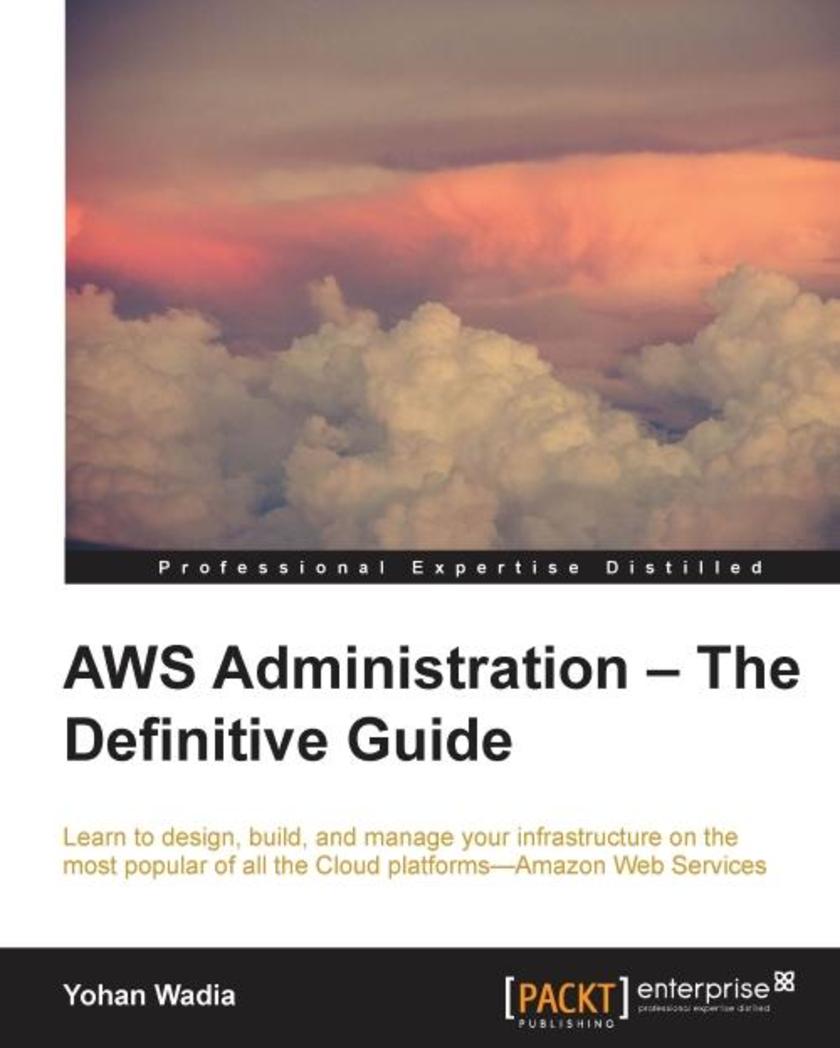
AWS Administration – The Definitive Guide
¥80.65
Learn to design, build, and manage your infrastructure on the most popular of all the Cloud platforms—Amazon Web ServicesAbout This BookLearn how to leverage various Amazon Web Services (AWS) components and services to build a secure, reliable, and robust environment to host your applications onDeep dive into the core AWS service offerings with hands-on tutorials, real-world use case scenarios, and best practicesA self-paced, systematic, and step-by-step guide to learning and implementing AWS in your own environmentWho This Book Is ForThis book is for those who want to learn and leverage AWS. Although no prior experience with AWS is required, it is recommended that you have some hands-on experienceofLinux, Web Services, and basic networkingWhat You Will LearnA brief introduction to Cloud Computing and AWS accompanied by steps to sign up for your first AWS accountCreate and manage users, groups, and permissions using AWSS Identity and Access Management servicesGet started with deploying and accessing EC2 instances, working with EBS Volumes and SnapshotsCustomize and create your very own Amazon Machine ImageDesign and deploy your instances on a highly secured, network isolated environment using Amazon VPCEffectively monitor your AWS environment using specialized alarms, custom monitoring metrics, and much moreExplore the various benefits of Database-as-a-Service offerings and leverage them using Amazon RDS and Amazon DynamoDBTake an in-depth look at what’s new with AWS, including EC2 Container Service and Elastic File SystemIn DetailAWS is at the forefront of Cloud Computing today. Many businesses are moving away from traditional datacenters and toward AWS because of its reliability, vast service offerings, lower costs, and high rate of innovation. Because of its versatility and flexible design, AWS can be used to accomplish a variety of simple and complicated tasks such as hosting multitier websites, running large scale parallel processing, content delivery, petabyte storage and archival, and lots more.Whether you are a seasoned sysadmin or a rookie, this book will provide you with all the necessary skills to design, deploy, and manage your applications on the AWS cloud platform. The book guides you through the core AWS services such as IAM, EC2, VPC, RDS, and S3 using a simple real world application hosting example that you can relate to. Each chapter is designed to provide you with the most information possible about a particular AWS service coupled with easy to follow hands-on steps, best practices, tips, and recommendations.By the end of the book, you will be able to create a highly secure, fault tolerant, and scalable environment for your applications to run on.Style and approach This in-depth and insightful guide is filled with easy-to-follow examples, real-world use cases, best practices, and recommendations that will help you design and leverage AWS.
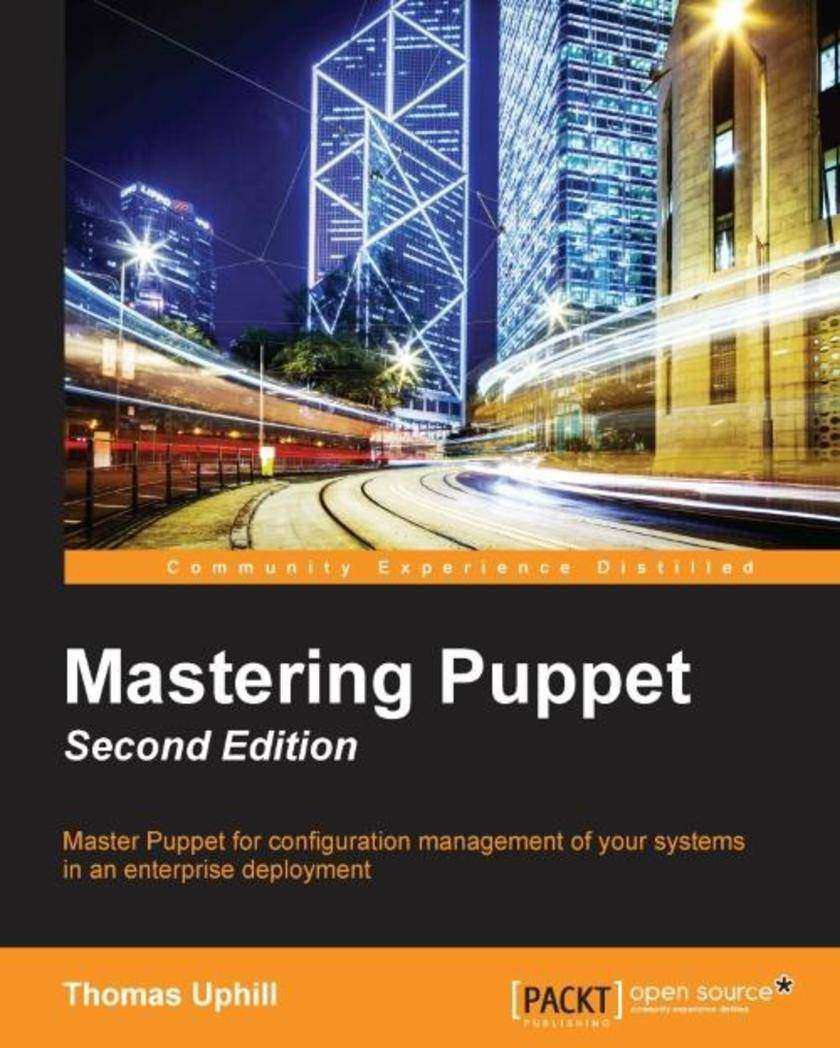
Mastering Puppet - Second Edition
¥90.46
Master Puppet for configuration management of your systems in an enterprise deploymentAbout This BookThis book is an advanced guide to using and deploying Puppet 4 in your organization with a special focus on issues faced in larger enterprise deploymentsFrom an experienced author, learn to deal with scaling, performance, and multiple developers with the help of real-world examplesThis is the most up-to-date guide on Puppet, and covers the advanced concepts of Puppet 4Who This Book Is ForThis book is for those who have intermediate knowledge of Puppet and are looking to deploy it in their environment. Some idea how to write simple modules for configuration management with Puppet is a prerequisite for this book.What You Will LearnScale out your Puppet infrastructure using proxying techniquesAutomate your code promotion workflow using Git and r10kSolve real-world problems using public modules from the Puppet ForgeUse Hiera to separate the data of your configuration from the code of your configurationWrite your own custom facts in RubyExtend Puppet with your own custom facts, modules, and typesUse exported resources to orchestrate change between machinesDebug a puppetserver using Java techniquesIn DetailPuppet is a configuration management system and a language. It was written for and by system administrators to manage large numbers of systems efficiently and prevent configuration drifts.Mastering Puppet deals with the issues faced when scaling out Puppet to handle large numbers of nodes. It will show you how to fit Puppet into your enterprise and allow many developers to work on your Puppet code simultaneously. In addition, you will learn to write custom facts and roll your own modules to solve problems. Next, popular options for performing reporting and orchestration tasks will be introduced in this book. Moving over to troubleshooting techniques, which will be very useful. The concepts presented are useful to any size organization.By the end of the book, you will know how to deal with problems of scale and exceptions in your code, automate workflows, and support multiple developers working simultaneously.Style and approachThis book is a step-wise guide packed with examples to help you configure complex systems in Puppet.
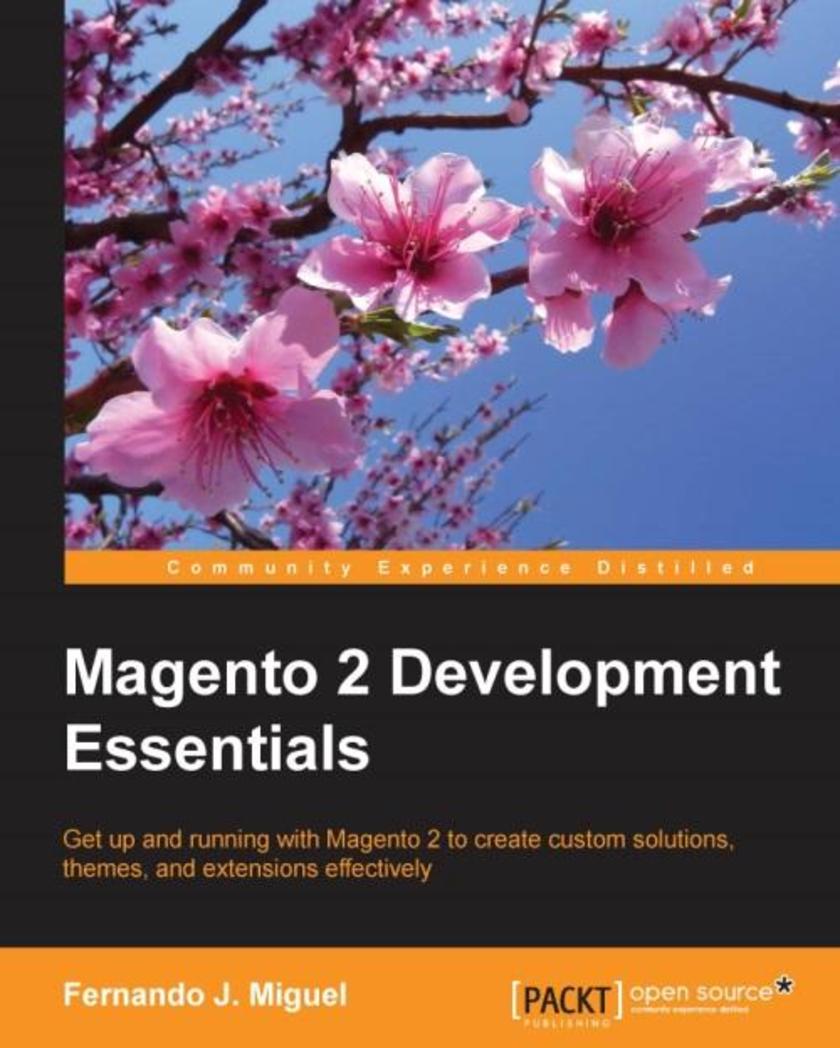
Magento 2 Development Essentials
¥54.49
Get up and running with Magento 2 to create custom solutions, themes, and extensions effectivelyAbout This BookCreate unique solutions for Magento 2 by developing and implementing solutions, themes, and extensionsBe proficient in the main functionalities, resources, and system structure of Magento 2Get to grips with this practical and hands-on guide to raise your web development skills to the next levelWho This Book Is ForIf you are a PHP developer who wants to improve your skills in e-commerce development by creating themes and extensions for Magento 2, then this book is for you.What You Will LearnInstall and set up the Magento EcosystemChoose the best options for Magento’s Sell System featuresWork with Search Engine Optimization in MagentoCreate and customize themes for MagentoDevelop extensions for new Magento functionalitiesPackage extensions to publish in the Magento Connect networkCreate Magento solutions for mobile devicesCarry out performance adjustments to speed up your Magento systemIn DetailMagento is the e-commerce software and platform trusted by the world's leading brands. Used by thousands of merchants for their transactions worth billions, it provides the flexibility to customize the content and functionality of your website. By strengthening your fundamentals in Magento development, you can develop the best solutions and take advantage of the growing market.This fast-paced tutorial will provide you with skills you need to successfully create themes, extensions, and solutions to Magento 2 projects.This book begins by setting up Magento 2 before gradually moving onto setting the basic options of the Sell System. You will take advantage of Search Engine Optimization aspects, create design and customize theme layout, develop new extensions, and adjust the Magento System to achieve great performance. By sequentially working through the steps in each chapter, you will quickly explore all the features of Magento 2 to create a great solution.With ample examples and a practical approach, this book will ensure your success with this astonishing e-commerce management system.Style and approachThis book would be a fast-paced tutorial guide that uses hands-on examples to developing new solutions for Magento e-commerce system. Each topic is explained sequentially in the process of creating a Magento solution, along with detailed explanations of the basic and advanced features of Magento 2.
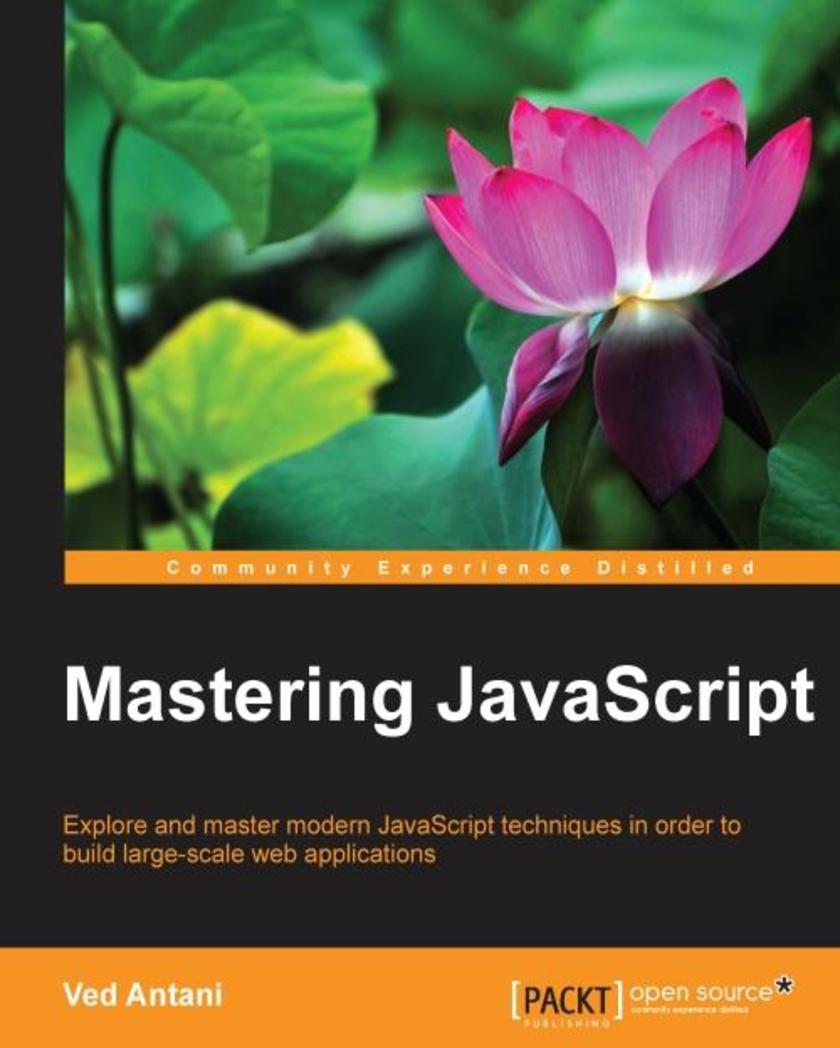
Mastering JavaScript
¥80.65
Explore and master modern JavaScript techniques in order to build large-scale web applicationsAbout This BookWrite powerful code with the high-level functions that JavaScript offersTest and debug issues with JavaScript code using various modern mechanismsOffers an expert's eye on the latest ES6 features and how these advanced tasks fit together in JavaScript as a wholeWho This Book Is ForThis book is ideal for web developers who are looking to master modern JavaScript concepts and design principles. You should already have an intermediate level of JavaScript knowledge before starting this book.What You Will LearnGet a run through of the basic JavaScript language constructsGet familiar with the Functions and Closures of JavaScriptExplore Regular Expressions in JavaScriptCode using the powerful object-oriented feature in JavaScriptTest and debug your code using JavaScript strategiesMaster DOM manipulation, cross-browser strategies, and ES6Understand the basic concurrency constructs in Java* and best performance strategiesLearn to build scalable server application in JavaScript using Node.jsIn DetailJavaScript is a high-level, dynamic, untyped, lightweight, and interpreted programming language. Along with HTML and CSS, it is one of the three essential technologies of World Wide Web content production, and is an open source and cross-platform technology. The majority of websites employ JavaScript, and it is well supported by all modern web browsers without plugins. However, the JavaScript landscape has changed dramatically in recent years, and you need to adapt to the new world of JavaScript that people now expect. Mastering modern JavaScript techniques and the toolchain are essential to develop web-scale applications.Mastering JavaScript will be your companion as you master JavaScript and build innovative web applications. To begin with, you will get familiarized with the language constructs and how to make code easy to organize. You will gain a concrete understanding of variable scoping, loops, and best practices on using types and data structures, as well as the coding style and recommended code organization patterns in JavaScript. The book will also teach you how to use arrays and objects as data structures. You will graduate from intermediate-level skills to advanced techniques as you come to understand crucial language concepts and design principles. You will learn about modern libraries and tools so you can write better code.By the end of the book, you will understand how reactive JavaScript is going to be the new paradigm.Style and approachThis is a comprehensive guide with a clear focus on practical use cases and patterns. Each chapter consists of best practices, useful advice, and a bunch of easy-to-follow examples that will build up your skills as you advance through the book.
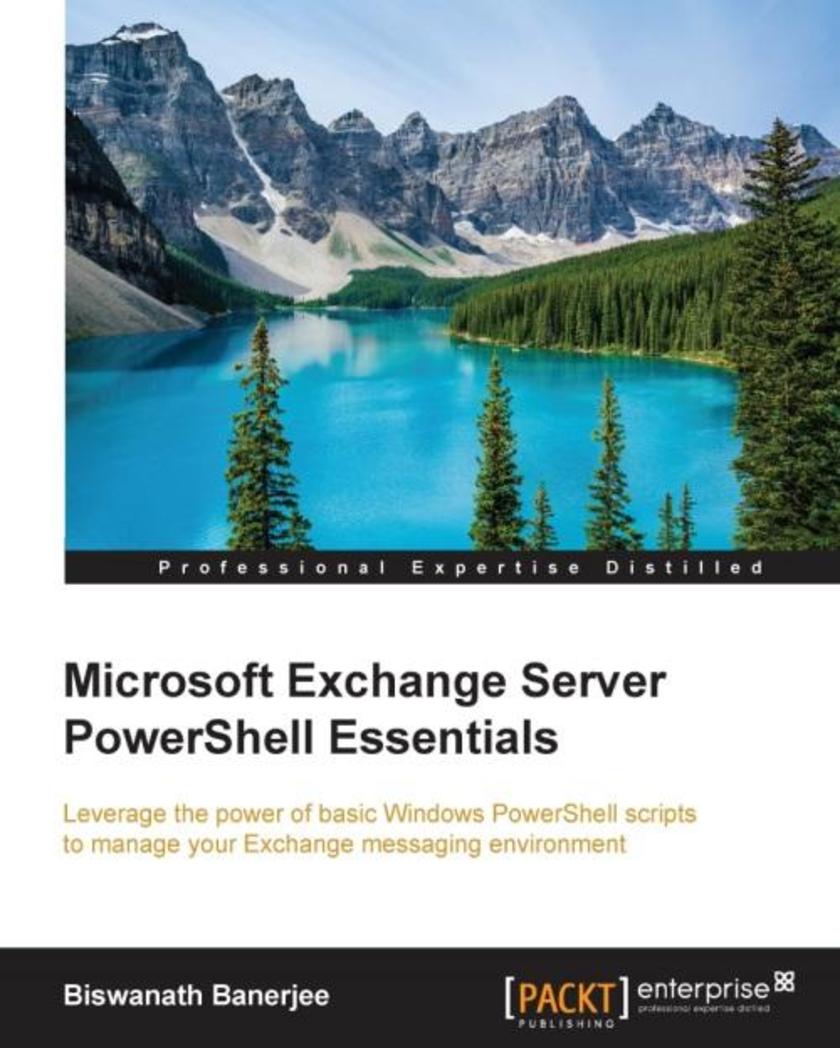
Microsoft Exchange Server PowerShell Essentials
¥63.21
Leverage the power of basic Windows PowerShell *s to manage your Exchange messaging environmentAbout This BookGet to grips with Windows PowerShell and how it can be used to manage various aspects of the operating system and applicationsBecome proficient in PowerShell and apply it to manage Exchange infrastructure on-premise or via Exchange Online as part of Office 365Learn to create Windows PowerShell *s to do administrative tasks with this step-by-step, easy-to-follow guideWho This Book Is ForThis book is for administrators with a basic or limited understanding of Windows PowerShell and who want to increase their skill set in managing both the Exchange On Premise and Online environments.What You Will LearnDeep dive into the Windows PowerShell basicsCreate and manage Recipients and permissionsManage Distribution Group members, permissions, and group typesUnderstand Certificates and Role-Based Access Control using real-world examplesReview the usage of email address, address book, and retention policies with examplesLearn to manage Exchange Client Access and Mailbox Server rolesUse PowerShell for auditing and risk management in your Exchange organizationManage a highly available Exchange environment using PowerShellInteract with Exchange through the use of the Exchange Web Services-managed APIIn DetailPowerShell has become one of the most important skills in an Exchange administrator's armory. PowerShell has proved its mettle so widely that, if you're not already starting to learn PowerShell, then you're falling behind the industry. It isn't difficult to learn PowerShell at all. In fact, if you've ever run commands from a CMD prompt, then you'll be able to start using PowerShell straightaway.This book will walk you through the essentials of PowerShell in Microsoft Exchange Server and make sure you understand its nitty gritty effectively.You will first walk through the core concepts of PowerShell and their applications. This book discusses ways to automate tasks and activities that are performed by Exchange administrators and that otherwise take a lot of manual effort.Microsoft Exchange PowerShell Essentials will provide all the required details for Active Directory, System, and Exchange administrators to help them understand Windows PowerShell and build the required *s to manage the Exchange Infrastructure.Style and approachThis book is written with its target audience in mind; concepts are explained and followed by real-life examples. A comprehensive * is provided in each chapter to give you hands-on practice with all the major commands used in it.
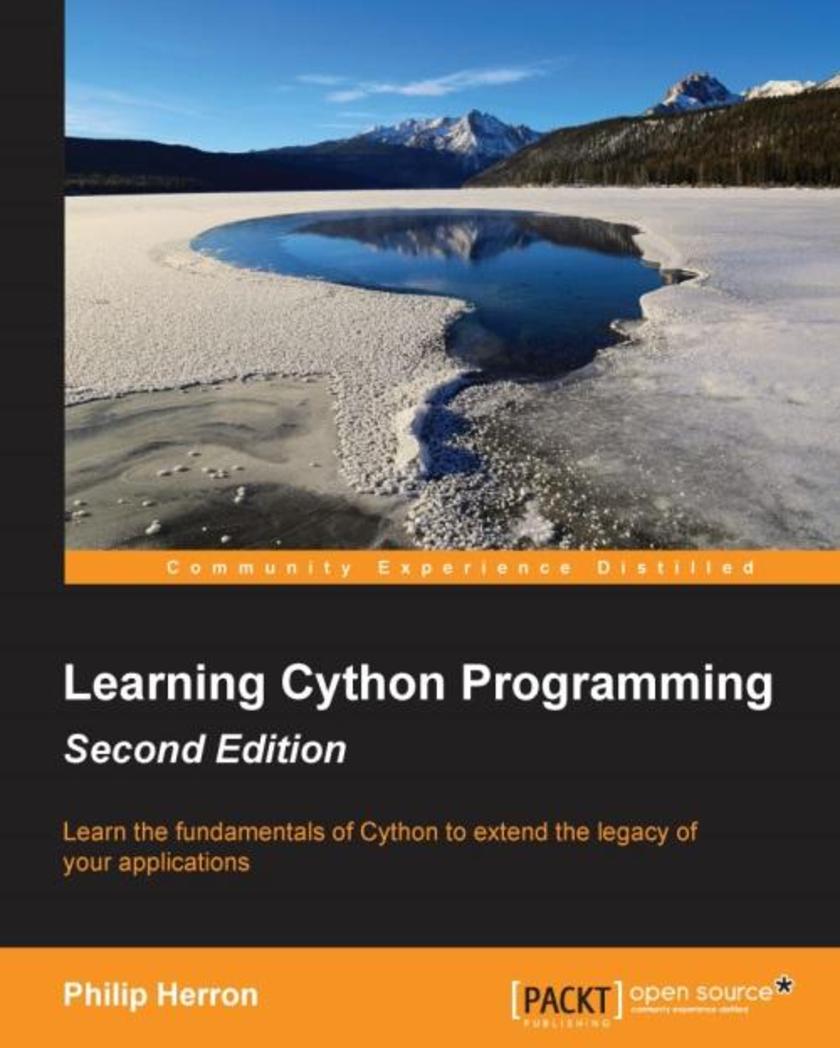
Learning Cython Programming - Second Edition
¥63.21
Learn the fundamentals of Cython to extend the legacy of your applicationsAbout This BookLearn how to extend C applications with pure Python codeGet more from Python – you’ll not only learn Cython, you’ll also unlock a greater understanding of how to harness PythonPacked with tips and tricks that make Cython look easy, dive into this accessible programming guide and find out what happens when you bring C and Python together!Who This Book Is ForThis book is for developers who are familiar with the basics of C and Python programming and wish to learn Cython programming to extend their applications.What You Will LearnReuse Python logging in CMake an IRC bot out of your C applicationExtend an application so you have a web server for rest callsPractice Cython against your C++ codeDiscover tricks to work with Python ConfigParser in CCreate Python bindings for native librariesFind out about threading and concurrency related to GILExpand Terminal Multiplexer Tmux with CythonIn DetailCython is a hybrid programming language used to write C extensions for Python language. Combining the practicality of Python and speed and ease of the C language it’s an exciting language worth learning if you want to build fast applications with ease.This new edition of Learning Cython Programming shows you how to get started, taking you through the fundamentals so you can begin to experience its unique powers.You’ll find out how to get set up, before exploring the relationship between Python and Cython. You’ll also look at debugging Cython, before moving on to C++ constructs, Caveat on C++ usage, Python threading and GIL in Cython. Finally, you’ll learn object initialization and compile time, and gain a deeper insight into Python 3, which will help you not only become a confident Cython developer, but a much more fluent Python developer too.Style and approachThis practical and a fast-paced guide gives you all the information you need to start programming using Cython.
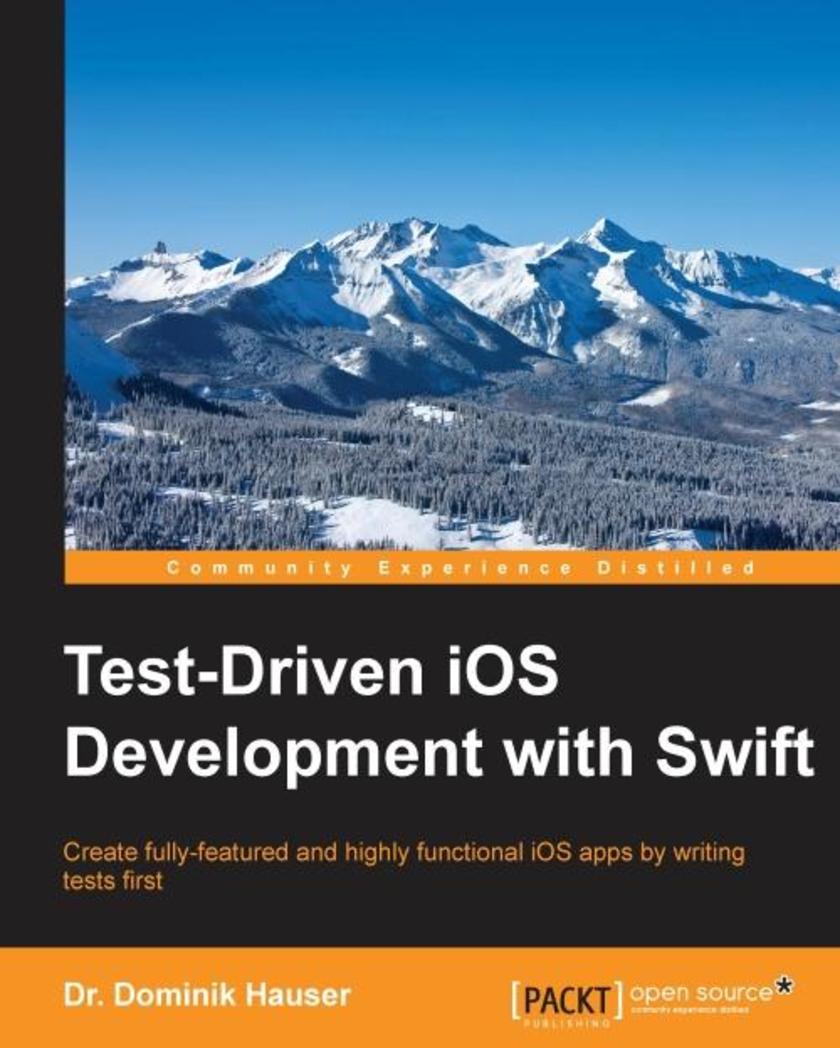
Test-Driven iOS Development with Swift
¥71.93
Create fully-featured and highly functional iOS apps by writing tests firstAbout This BookLearn test-driven principles to help you build apps with fewer bugs and better designsBecome more efficient while working with Swift to move on to your next project faster!Learn how to incorporate all of the principles of test-driven development (TDD) in to your daily programming workflowWho This Book Is ForIf debugging iOS apps is a nerve-racking task for you and you are looking for a fix, this book is for you.What You Will LearnImplement TDD in swift application developmentGet to know the fundamentals, life cycle, and benefits of TDDExplore the tools and frameworks to effectively use TDDDevelop models and controllers driven by testsConstruct the network layer using stubsUse functional tests to ensure the app works as plannedAutomate and streamline the building, analysing, testing, and archiving of your iOS appsIn DetailTest-driven development (TDD) is a proven way to find software bugs early. Writing tests before your code improves the structure and maintainability of your app.Test-driven iOS Development with Swift will help you understand the process of TDD and how it impacts your applications written in Swift. Through practical, real-world examples, you’ll start seeing how to implement TDD in context. We will begin with an overview of your TDD workflow and then deep-dive into unit testing concepts and code cycles. We will showcase the workings of functional tests, which will help you improve the user interface. Finally, you will learn about automating deployments and continuous integration to run an environment.Style and approachThis is an easy-to-follow example-driven tutorial, packed with lots of tips and tricks that explore TDD bit-by-bit in the process of making an iOS application.

Getting Started with ResearchKit
¥80.65
Enter the era of medical research using mobile devices with the help of this guide on ResearchKit!About This BookCreate a simple clinical research app using most aspects of ResearchKitBuild a simple survey with various data types with the results printed on the screen.A step-by-step guide introducing Apple's ResearchKit and techniques to incorporate it into various apps.Who This Book Is ForThis book is aimed at medical researchers with basic iOS coding knowledge and iOS developers looking to create clinical research apps.What You Will LearnLearn to create customized consent formGet introduced to two backend services: a simple backend server using Sinatra and Sage BridgeBuild a custom task (a conditional survey example) and a navigable taskGet an Overview of ResearchKit's open source repository and App CoreInteraction with the hardware of the device including the gyro and the motion sensorsLearn the basics of this revolutionary technologyGet introduced to the barebones app and learn to write your first codeIn DetailResearchKit is an open source software development framework from Apple that lets you easily create mobile applications for clinical research studies. ResearchKit provides you the ability to orchestrate the administration of tasks and recording of the results. ResearchKit provides tasks in order to perform informed consent, active tasks, and surveys.Starting with the basics of the ResearchKit framework, this books walks you through the steps of creating iOS applications that could serve as the basis of a clinical research mobile app.This book will introduce readers to ResearchKit and how to turn your iPhone into into a clinical research tool. The book will start off by installing and building the research framework in line with the researcher's needs; during this, the reader will learn to embed ResearchKit in the application and create a small task.After this, the book will go a little deeper into creating modules for surveys, consents, and so on. The book will also cover the various aspects of privacy and security with regard to participant data, and how to build dashboards for visualizing medical data and results in line with the researcher's requirements: data backends, JSON serialization and deserialization, and so on.Readers will be able to fully utilize ResearchKit for medical research, will be able to get more and more patients to participate in their surveys, and will gain insights from the surveys using the dashboards created.Style and approachA hands-on guide with ample screenshots for you to follow and learn about ResearchKit. Each topic is explained sequentially and placed in context so that you can get a better understanding of every step in the process of creating clinical research apps.

Geospatial Development By Example with Python
¥90.46
Build your first interactive map and build location-aware applications using cutting-edge examples in PythonAbout This BookLearn the full geo-processing workflow using Python with open source packagesCreate press-quality styled maps and data visualization with high-level and reusable codeProcess massive datasets efficiently using parallel processingWho This Book Is ForGeospatial Development By Example with Python is intended for beginners or advanced developers in Python who want to work with geographic data. The book is suitable for professional developers who are new to geospatial development, for hobbyists, or for data scientists who want to move into some simple development.What You Will LearnPrepare a development environment with all the tools needed for geo-processing with PythonImport point data and structure an application using Python’s resourcesCombine point data from multiple sources, creating intuitive and functional representations of geographic objectsFilter data by coordinates or attributes easily using pure PythonMake press-quality and replicable maps from any dataDownload, transform, and use remote sensing data in your mapsMake calculations to extract information from raster data and show the results on beautiful mapsHandle massive amounts of data with advanced processing techniquesProcess huge satellite images in an efficient wayOptimize geo-processing times with parallel processingIn DetailFrom Python programming good practices to the advanced use of analysis packages, this book teaches you how to write applications that will perform complex geoprocessing tasks that can be replicated and reused.Much more than simple *s, you will write functions to import data, create Python classes that represent your features, and learn how to combine and filter them.With pluggable mechanisms, you will learn how to visualize data and the results of analysis in beautiful maps that can be batch-generated and embedded into documents or web pages.Finally, you will learn how to consume and process an enormous amount of data very efficiently by using advanced tools and modern computers’ parallel processing capabilities.Style and approachThis easy-to-follow book is filled with hands-on examples that illustrate the construction of three sample applications of how to write reusable and interconnected Python code for geo-processing.
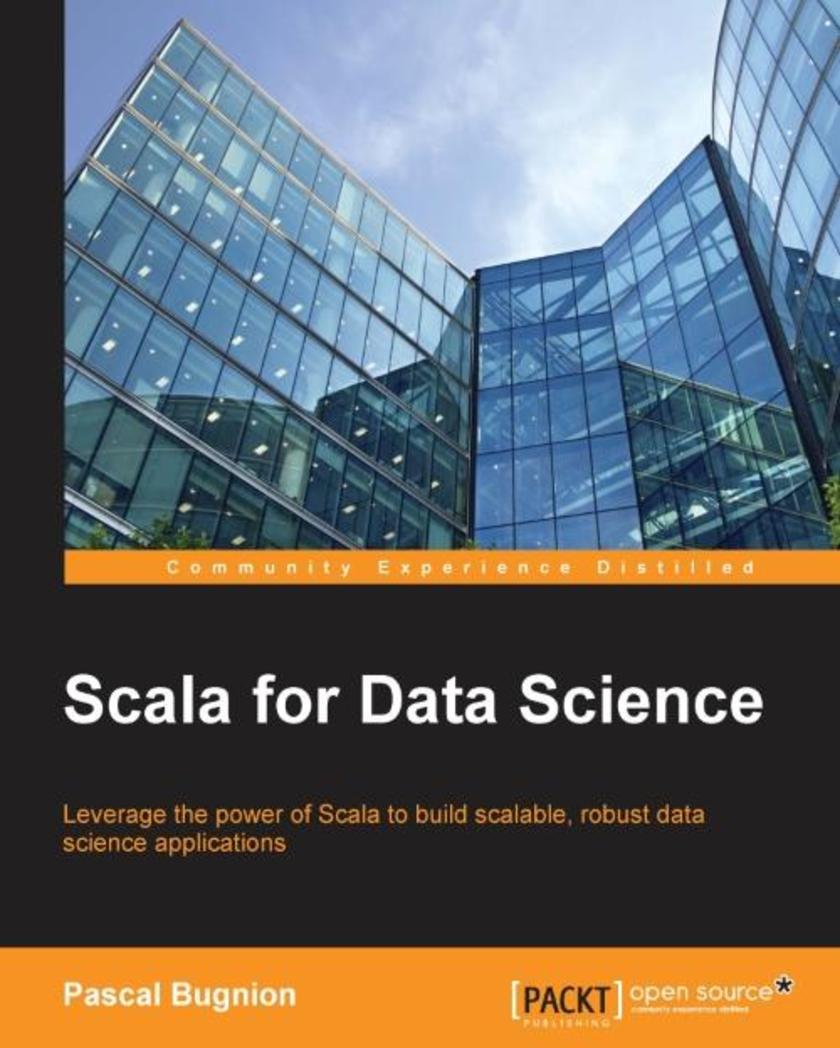
Scala for Data Science
¥99.18
Leverage the power of Scala with different tools to build scalable, robust data science applicationsAbout This BookA complete guide for scalable data science solutions, from data ingestion to data visualizationDeploy horizontally scalable data processing pipelines and take advantage of web frameworks to build engaging visualizationsBuild functional, type-safe routines to interact with relational and NoSQL databases with the help of tutorials and examples providedWho This Book Is ForIf you are a Scala developer or data scientist, or if you want to enter the field of data science, then this book will give you all the tools you need to implement data science solutions.What You Will LearnTransform and filter tabular data to extract features for machine learningImplement your own algorithms or take advantage of MLLib’s extensive suite of models to build distributed machine learning pipelinesRead, transform, and write data to both SQL and NoSQL databases in a functional mannerWrite robust routines to query web APIsRead data from web APIs such as the GitHub or Twitter APIUse Scala to interact with MongoDB, which offers high performance and helps to store large data sets with uncertain query requirementsCreate Scala web applications that couple with JavaScript libraries such as D3 to create compelling interactive visualizationsDeploy scalable parallel applications using Apache Spark, loading data from HDFS or HiveIn DetailScala is a multi-paradigm programming language (it supports both object-oriented and functional programming) and *ing language used to build applications for the JVM. Languages such as R, Python, Java, and so on are mostly used for data science. It is particularly good at analyzing large sets of data without any significant impact on performance and thus Scala is being adopted by many developers and data scientists. Data scientists might be aware that building applications that are truly scalable is hard. Scala, with its powerful functional libraries for interacting with databases and building scalable frameworks will give you the tools to construct robust data pipelines.This book will introduce you to the libraries for ingesting, storing, manipulating, processing, and visualizing data in Scala.Packed with real-world examples and interesting data sets, this book will teach you to ingest data from flat files and web APIs and store it in a SQL or NoSQL database. It will show you how to design scalable architectures to process and modelling your data, starting from simple concurrency constructs such as parallel collections and futures, through to actor systems and Apache Spark. As well as Scala’s emphasis on functional structures and immutability, you will learn how to use the right parallel construct for the job at hand, minimizing development time without compromising scalability. Finally, you will learn how to build beautiful interactive visualizations using web frameworks.This book gives tutorials on some of the most common Scala libraries for data science, allowing you to quickly get up to speed with building data science and data engineering solutions.Style and approachA tutorial with complete examples, this book will give you the tools to start building useful data engineering and data science solutions straightaway
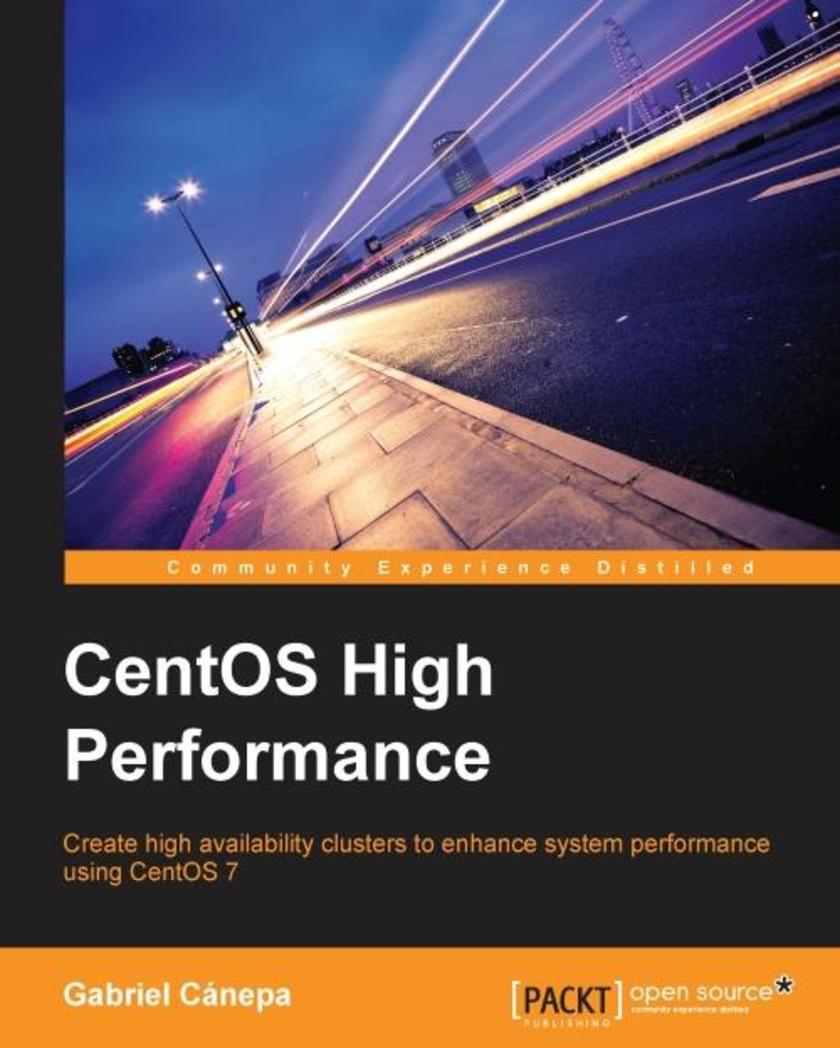
CentOS High Performance
¥63.21
Create high availability clusters to enhance system performance using CentOS 7About This BookMaster the concepts of high performance and high availability to eliminate performance bottlenecksMaximize the uptime of services running in a CentOS 7 clusterA step-by-step guide that will provide knowledge of methods and approaches to optimize the performance of CentOS clustersWho This Book Is ForThis book is targeted at system administrators: those who want a detailed, step-by-step guide to learn how to set up a high-availability CentOS 7 cluster, and those who are looking for a reference book to help them learn or refresh the necessary skills to ensure their systems and respective resources are utilized optimally. No previous knowledge of high-availability systems is needed, though the reader is expected to have at least some degree of familiarity with any spin-off of the Fedora family of Linux distributions, preferably CentOS.What You Will LearnInstall a CentOS 7 cluster and network infrastructureConfigure firewall, networking, and clustering services and settingsSet up and test a HAC (high-availability cluster) to host an Apache web server and a MariaDB database serverMonitor performance and availabilityIdentify bottlenecks and troubleshoot issuesImprove performance and ensure high availabilityIn DetailCentOS is the enterprise level Linux OS, which is 100% binary compatible to Red Hat Enterprise Linux (RHEL). It acts as a free alternative to RedHat's commercial Linux offering, with only a change in the branding. A high performance cluster consists in a group of computers that work together as one set parallel, hence minimizing or eliminating the downtime of critical services and enhancing the performance of the application.Starting with the basic principles of clustering, you will learn the necessary steps to install a cluster with two CentOS 7 servers. We will then set up and configure the basic required network infrastructure and clustering services. Further, you will learn how to take a proactive approach to the split-brain issue by configuring the failover and fencing of the cluster as a whole and the quorum of each node individually. Further, we will be setting up HAC and HPC clusters as a web server and a database server. You will also master the art of monitoring performance and availability, identifying bottlenecks, and exploring troubleshooting techniques.At the end of the book, you’ll review performance-tuning techniques for the recently installed cluster, test performance using a payload simulation, and learn the necessary skills to ensure that the systems, and the corresponding resources and services, are being utilized to their best capacity.Style and approachAn easy-to-follow and step-by-step guide with hands-on instructions to set up real-world simple cluster scenarios that will start you on the path to building more complex applications on your own.
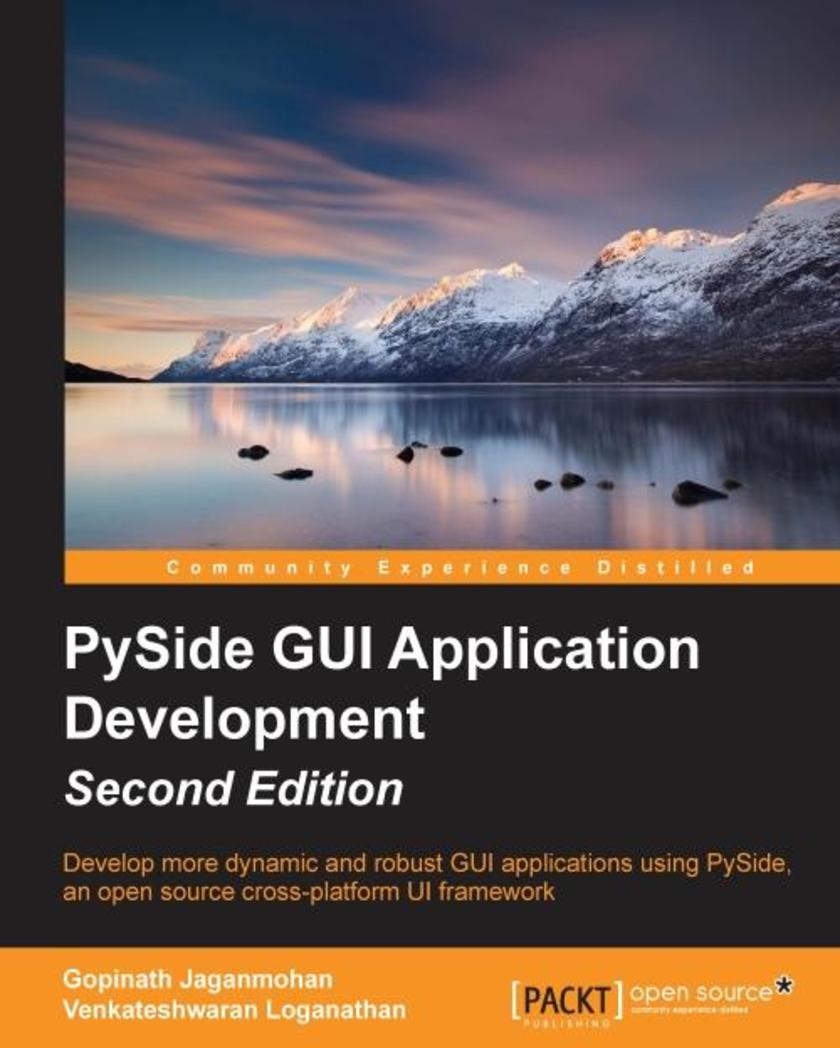
PySide GUI Application Development - Second Edition
¥54.49
Develop more dynamic and robust GUI applications using PySide, an open source cross-platform UI frameworkAbout This BookDesigned for beginners to help you get started with GUI application developmentDevelop your own applications by creating customized widgets and dialogsWritten in a simple and elegant structure so you easily understand how to program various GUI componentsWho This Book Is ForThis book is written for Python programmers who want to learn about GUI programming. It is also suitable for those who are new to Python but are familiar with object-oriented programming.What You Will LearnProgram GUI applications in an easy and efficient wayDownload and install PySide, a cross-platform GUI development toolkit for PythonCreate menus, toolbars, status bars, and child windowsDevelop a text editor application on your ownConnect your GUI to a database and manage itExecute SQL queries by handling databasesIn DetailElegantly-built GUI applications are always a massive hit among users. PySide is an open source software project that provides Python bindings for the Qt cross-platform UI framework. Combining the power of Qt and Python, PySide provides easy access to the Qt framework for Python developers and also acts as an excellent rapid application development platform.This book will take you through everything you need to know to develop UI applications. You will learn about installing and building PySide in various major operating systems as well as the basics of GUI programming. The book will then move on to discuss event management, signals and slots, and the widgets and dialogs available with PySide. Database interaction and manipulation is also covered.By the end of this book, you will be able to program GUI applications efficiently and master how to develop your own applications and how to run them across platforms.Style and approachThis is an accessible and practical guide to developing GUIs for Python applications.
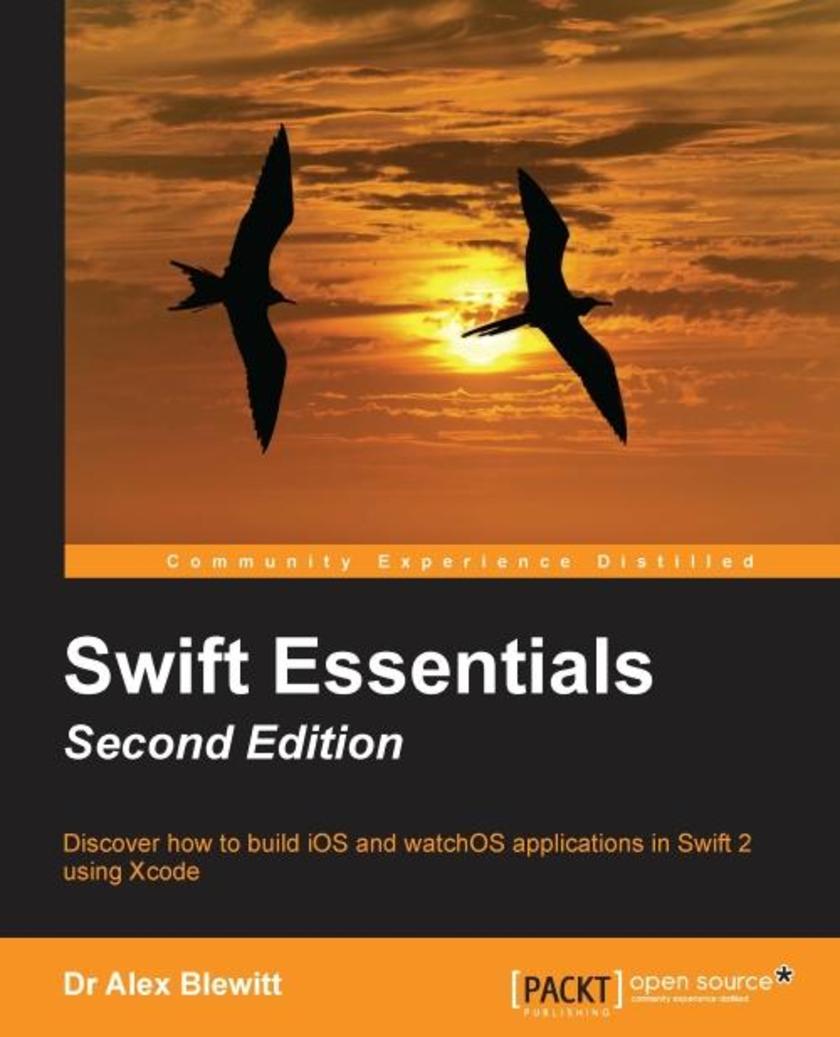
Swift Essentials - Second Edition
¥63.21
Discover how to build iOS and watchOS applications in Swift 2 using XcodeAbout This BookGets you up and running with Swift programming without any prior iOS development experience.A fast paced guide showing best practices and lets you get up to speed with Swift to quickly build your own iOS applicationsA unique practical approach to make your life with Swift easy.Who This Book Is ForAre you interested in learning SwiftDo you want to write iOS applications in SwiftIf yes, then this is the book for you. No prior iOS programming experience is assumed; however, having some experience with any programming language will be beneficial.What You Will LearnDive into Swift and explore its innovative and powerful syntaxWork with Swift in Xcode to get a unique and productive approach to developmentFind out how to create complete iOS applicationsDiscover rapid prototyping with a Swift playgroundGet to know how to use the Swift storyboard to develop multi-page applicationsGet to grips with parsing JSON and XML data from network sourcesBuild a network client for GitHub repositories, with full source code on GitHubIn DetailSwift was considered one of the biggest innovations last year, and certainly with Swift 2 announced at WWDC in 2015, this segment of the developer space will continue to be hot and dominating.This is a fast-paced guide to provide an overview of Swift programming and then walks you through in detail how to write iOS applications. Progress through chapters on custom views, networking, parsing and build a complete application as a Git repository, all by using Swift as the core languageStyle and approachThis fast-paced practical guide will quickly give you hands-on experience with all the features of Swift programming. Following the practical examples in the book will help you successfully create your own iOS applications.
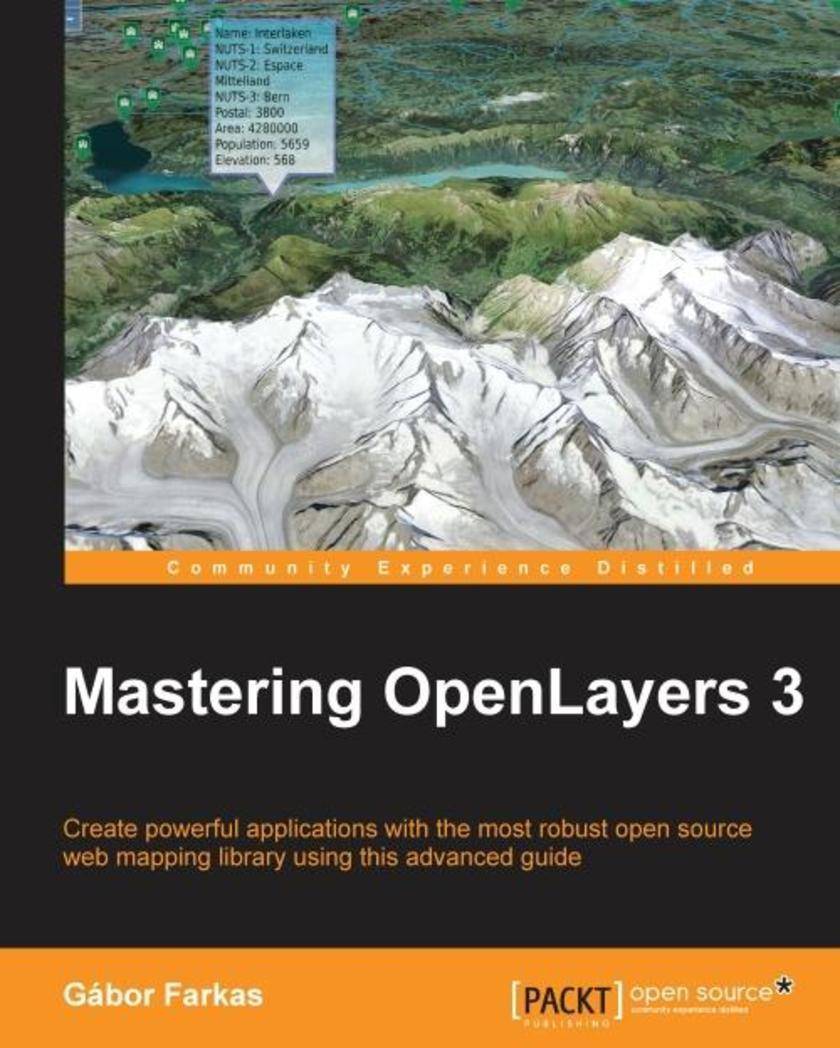
Mastering OpenLayers 3
¥90.46
Create powerful applications with the most robust open source web mapping library using this advanced guideAbout This BookDevelop responsive and platform-independent web mapping applications with OpenLayers 3Learn the key points of creating great applications with native JavaScript through the step-by-step examplesMaster the use of the library, from compiling custom builds to developing a complete WebGIS applicationWho This Book Is ForThis book is intended for front-end developers with basic understanding of JavaScript and GIS concepts, and preferably for those who are familiar with the fundamentals of OpenLayers 3. You might have never used OpenLayers 3 as a seasoned JavaScript developer. If this is the case and you are eager to learn web mapping, this book will definitely set you on the right track.What You Will LearnUse the advanced functionality of the OpenLayers 3 library effectivelyImplement the library in your application, shaping it to your needsManage layers and the layer stack dynamicallyCreate not only stunning but also accurate thematic mapsExtend OpenLayers 3 with your own custom classesDevelop mobile-friendly web mapping applicationsMake stunning effects with canvas manipulation, or visualize point clouds with WebGLIntegrate third-party applications, and create custom builds that completely satisfy your needsIn DetailOpenLayers 3 allows you to create stunning web mapping and WebGIS applications. It uses modern, cutting edge browser technologies. It is written with Closure Library, enabling you to build browser-independent applications without painful debugging ceremonies, which even have some limited fallback options for older browsers.With this guide, you will be introduced to the world of advanced web mapping and WebGIS.First, you will be introduced to the advanced features and functionalities available in OpenLayers 3. Next, you will be taken through the key points of creating custom applications with OpenLayers 3. You will then learn how to create the web mapping application of yours (or your company's) dream with this open source, expense-free, yet very powerful library. We’ll also show you how to make amazing looking thematic maps and create great effects with canvas manipulation.By the end of this book, you will have a strong command of web mapping and will be well on your way to creating amazing applications using OpenLayers 3.Style and approachThis is an advanced guide packed with comprehensive examples, and it concentrates on the advanced parts of OpenLayers 3 and JavaScript. It intentionally skips the basic and well-known methodologies, but discusses the hard-to-understand ones in great detail.
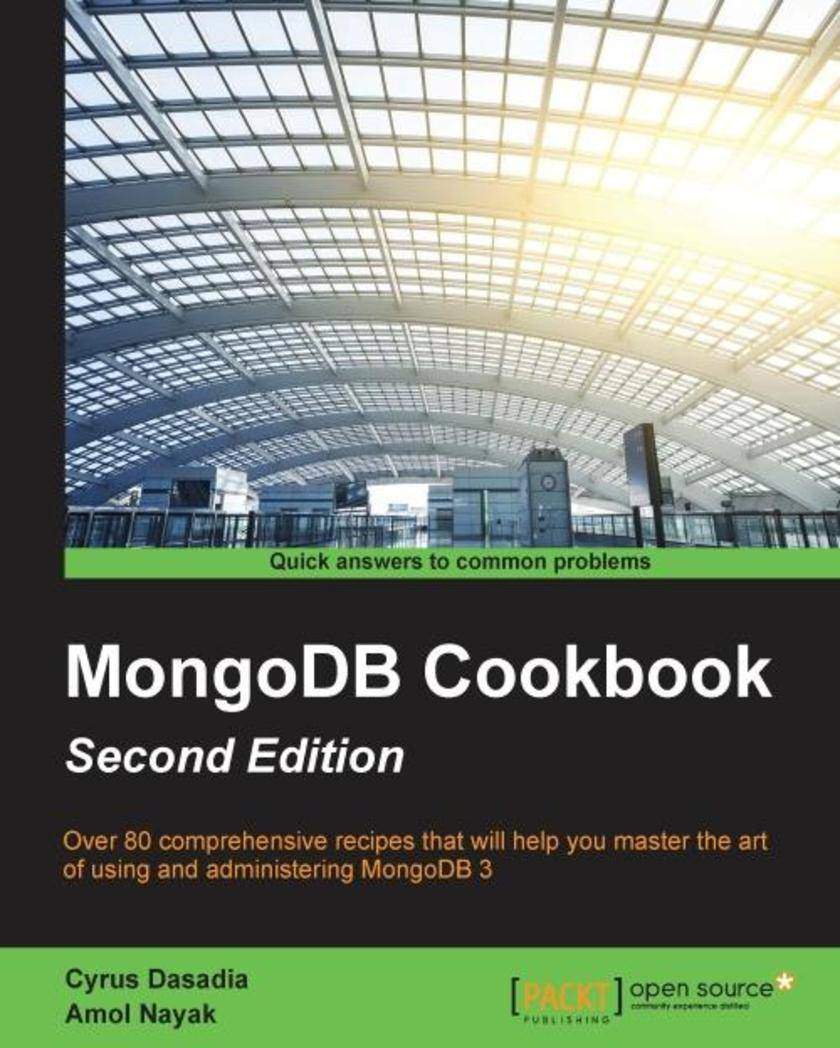
MongoDB Cookbook - Second Edition
¥80.65
Harness the latest features of MongoDB 3 with this collection of 80 recipes – from managing cloud platforms to app development, this book is a vital resourceAbout This BookGet to grips with the latest features of MongoDB 3Interact with the MongoDB server and perform a wide range of query operations from the shellFrom administration to automation, this cookbook keeps you up to date with the world’s leading NoSQL databaseWho This Book Is ForThis book is engineered for anyone who is interested in managing data in an easy and efficient way using MongoDB. You do not need any prior knowledge of MongoDB, but it would be helpful if you have some programming experience in either Java or Python.What You Will LearnInstall, configure, and administer MongoDB sharded clusters and replica setsBegin writing applications using MongoDB in Java and Python languagesInitialize the server in three different modes with various configurationsPerform cloud deployment and introduce PaaS for MongoDiscover frameworks and products built to improve developer productivity using MongoTake an in-depth look at the Mongo programming driver APIs in Java and PythonSet up enterprise class monitoring and backups of MongoDBIn DetailMongoDB is a high-performance and feature-rich NoSQL database that forms the backbone of the systems that power many different organizations – it’s easy to see why it’s the most popular NoSQL database on the market. Packed with many features that have become essential for many different types of software professionals and incredibly easy to use, this cookbook contains many solutions to the everyday challenges of MongoDB, as well as guidance on effective techniques to extend your skills and capabilities.This book starts with how to initialize the server in three different modes with various configurations. You will then be introduced to programming language drivers in both Java and Python. A new feature in MongoDB 3 is that you can connect to a single node using Python, set to make MongoDB even more popular with anyone working with Python. You will then learn a range of further topics including advanced query operations, monitoring and backup using MMS, as well as some very useful administration recipes including SCRAM-SHA-1 Authentication. Beyond that, you will also find recipes on cloud deployment, including guidance on how to work with Docker containers alongside MongoDB, integrating the database with Hadoop, and tips for improving developer productivity.Created as both an accessible tutorial and an easy to use resource, on hand whenever you need to solve a problem, MongoDB Cookbook will help you handle everything from administration to automation with MongoDB more effectively than ever before.Style and approachEvery recipe is explained in a very simple set-by-step manner yet is extremely comprehensive.
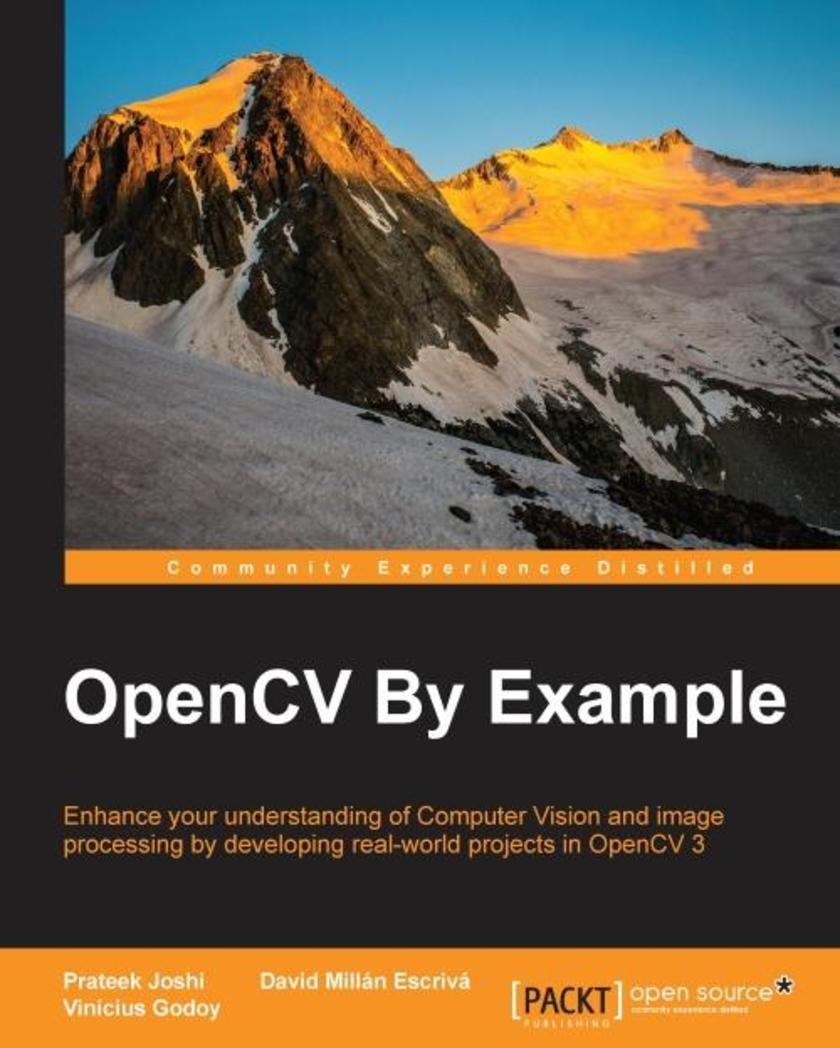
OpenCV By Example
¥90.46
Enhance your understanding of Computer Vision and image processing by developing real-world projects in OpenCV 3About This BookGet to grips with the basics of Computer Vision and image processingThis is a step-by-step guide to developing several real-world Computer Vision projects using OpenCV 3This book takes a special focus on working with Tesseract OCR, a free, open-source library to recognize text in imagesWho This Book Is ForIf you are a software developer with a basic understanding of Computer Vision and image processing and want to develop interesting Computer Vision applications with Open CV, this is the book for you. Knowledge of C++ is required.What You Will LearnInstall OpenCV 3 on your operating systemCreate the required CMake *s to compile the C++ application and manage its dependenciesGet to grips with the Computer Vision workflows and understand the basic image matrix format and filtersUnderstand the segmentation and feature extraction techniquesRemove backgrounds from a static scene to identify moving objects for video surveillanceTrack different objects in a live video using various techniquesUse the new OpenCV functions for text detection and recognition with TesseractIn DetailOpen CV is a cross-platform, free-for-use library that is primarily used for real-time Computer Vision and image processing. It is considered to be one of the best open source libraries that helps developers focus on constructing complete projects on image processing, motion detection, and image segmentation.Whether you are completely new to the concept of Computer Vision or have a basic understanding of it, this book will be your guide to understanding the basic OpenCV concepts and algorithms through amazing real-world examples and projects.Starting from the installation of OpenCV on your system and understanding the basics of image processing, we swiftly move on to creating optical flow video analysis or text recognition in complex scenes, and will take you through the commonly used Computer Vision techniques to build your own Open CV projects from scratch.By the end of this book, you will be familiar with the basics of Open CV such as matrix operations, filters, and histograms, as well as more advanced concepts such as segmentation, machine learning, complex video analysis, and text recognition.Style and approachThis book is a practical guide with lots of tips, and is closely focused on developing Computer vision applications with OpenCV. Beginning with the fundamentals, the complexity increases with each chapter. Sample applications are developed throughout the book that you can execute and use in your own projects.
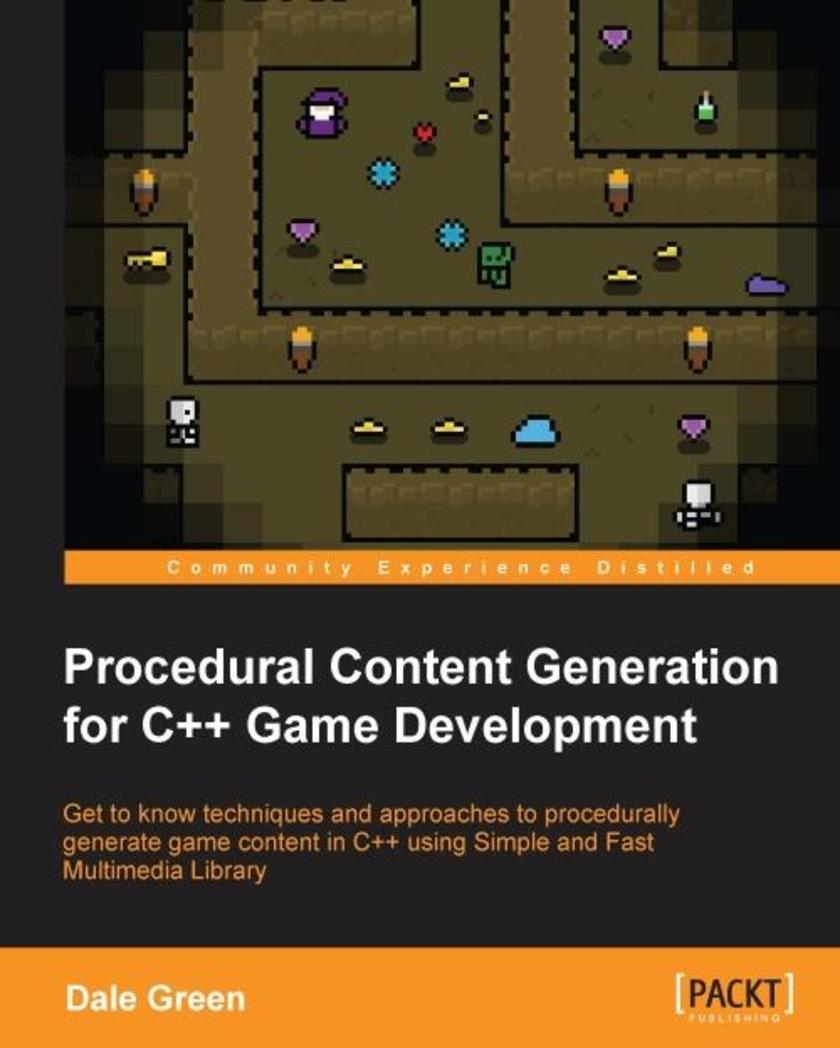
Procedural Content Generation for C++ Game Development
¥90.46
Get to know techniques and approaches to procedurally generate game content in C++ using Simple and Fast Multimedia LibraryAbout This BookThis book contains a bespoke Simple and Fast Multimedia Library (SFML) game engine with complete online documentationThrough this book, you’ll create games that are non-predictable and dynamic and have a high replayability factorGet a breakdown of the key techniques and approaches applied to a real game.Who This Book Is ForIf you are a game developer who is familiar with C++ and is looking to create bigger and more dynamic games, then this book is for you. The book assumes some prior experience with C++, but any intermediate concepts are clarified in detail. No prior experience with SFML is required.What You Will LearnDiscover the systems and ideology that lie at the heart of procedural systemsUse Random number generation (RNG) with C++ data types to create random but controlled resultsBuild levels procedurally with randomly located items and eventsCreate dynamic game objects at runtimeConstruct games using a component-based approachAssemble non-predictable game events and scenariosOperate procedural generation to create dynamic content fast and easilyGenerate game environments for endless replayabilityIn DetailProcedural generation is a growing trend in game development. It allows developers to create games that are bigger and more dynamic, giving the games a higher level of replayability. Procedural generation isn’t just one technique, it’s a collection of techniques and approaches that are used together to create dynamic systems and objects. C++ is the industry-standard programming language to write computer games. It’s at the heart of most engines, and is incredibly powerful. SFML is an easy-to-use, cross-platform, and open-source multimedia library. Access to computer hardware is broken into succinct modules, making it a great choice if you want to develop cross-platform games with ease.Using C++ and SFML technologies, this book will guide you through the techniques and approaches used to generate content procedurally within game development.Throughout the course of this book, we’ll look at examples of these technologies, starting with setting up a roguelike project using the C++ template. We’ll then move on to using RNG with C++ data types and randomly scattering objects within a game map. We will create simple console examples to implement in a real game by creating unique and randomised game items, dynamic sprites, and effects, and procedurally generating game events. Then we will walk you through generating random game maps. At the end, we will have a retrospective look at the project.By the end of the book, not only will you have a solid understanding of procedural generation, but you’ll also have a working roguelike game that you will have extended using the examples provided.Style and approachThis is an easy-to-follow guide where each topic is explained clearly and thoroughly through the use of a bespoke example, then implemented in a real game project.
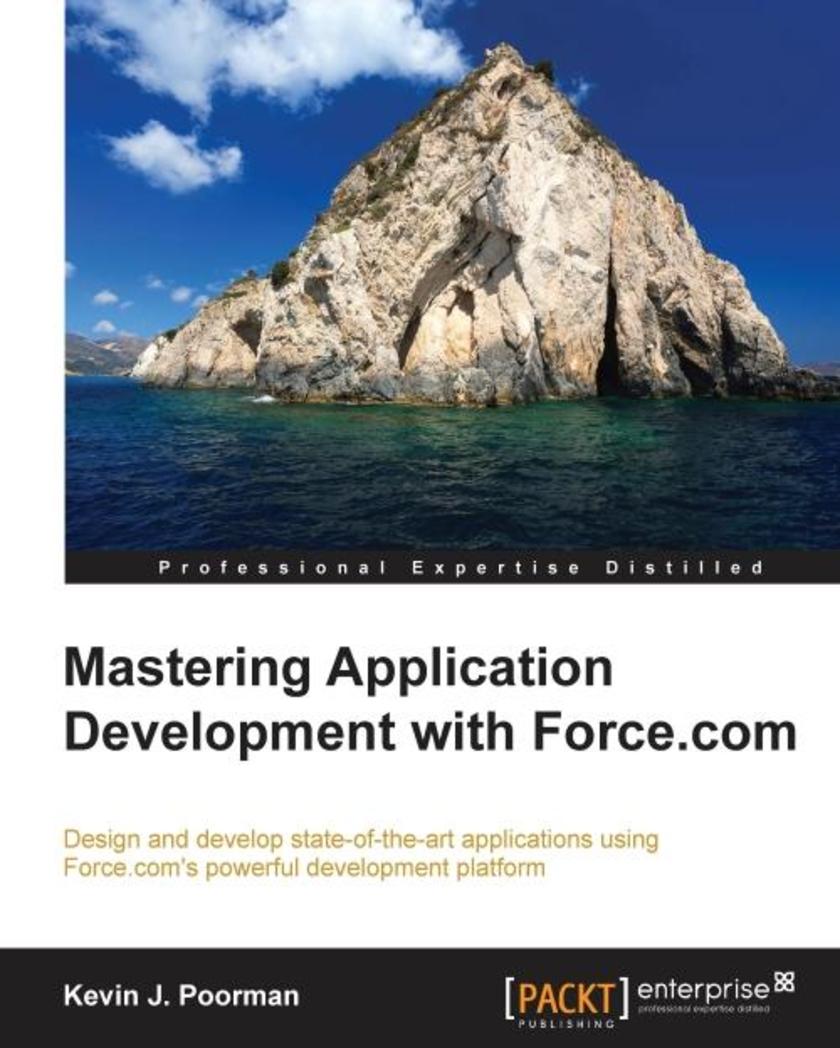
Mastering Application Development with Force.com
¥63.21
Design and develop state-of-the-art applications using Force.com's powerful development platformAbout This BookFlaunt your skillsets by developing complex applications that include demanding concepts such as triggers, Visualforce controllers, batch jobs, and Lightning componentsEarn the gratitude of your colleagues by structuring a project so that multiple developers can work independently of each otherKevin Poorman, the author of the book and a Force.com MVP, shares his years of Force.com knowledge and experience with you through the medium of telling examplesWho This Book Is ForIf you're a Force.com developer with a fundamental understanding of Apex and JavaScript but now want to enhance your skills with tips, tricks, and guidance on the best architectural and engineering practices, then this book is for you.What You Will LearnCreating triggers, and the best practices for writing themDeveloping a number of Visualforce controllers and extensionsIntegrating third-party web APIs into your Apex codeWriting unit tests that cover testing bulk safety, user and profile settings, and negative testsCreating a Lightning component for use in Salesforce1Getting acquainted with various methods for deploying metadata between orgsUsing the Rest sObject API for access to Salesforce objects and data using the REST methodologyLearning about overarching architectural considerations such as naming conventions, testing practices, and data modeling practicesIn DetailForce.com is an extremely powerful, scalable, and secure cloud platform, delivering a complete technology stack, ranging from databases and security to workflow and the user interface. With salesforce.com's Force.com cloud platform, you can build any business application and run it on your servers.The book will help you enhance your skillset and develop complex applications using Force.com. It gets you started with a quick refresher of Force.com's development tools and methodologies, and moves to an in-depth discussion of triggers, bulkification, DML order of operations, and trigger frameworks. Next, you will learn to use batchable and schedulable interfaces to process massive amounts of information asynchronously. You will also be introduced to Salesforce Lightning and cover components—including backend (apex) controllers, frontend (JavaScript) controllers, events, and attributes—in detail.Moving on, the book will focus on testing various apex components: what to test, when to write the tests, and—most importantly—how to test. Next, you will develop a changeset and use it to migrate your code from one org to another, and learn what other tools are out there for deploying metadata. You will also use command-line tools to authenticate and access the Force.com Rest sObject API and the Bulk sObject API; additionally, you will write a custom Rest endpoint, and learn how to structure a project so that multiple developers can work independently of each other without causing metadata conflicts.Finally, you will take an in-depth look at the overarching best practices for architecture (structure) and engineering (code) applications on the Force.com platform.Style and approach A step-by-step tutorial, with plenty of tips and tricks that will help you develop complex Force.com applications.
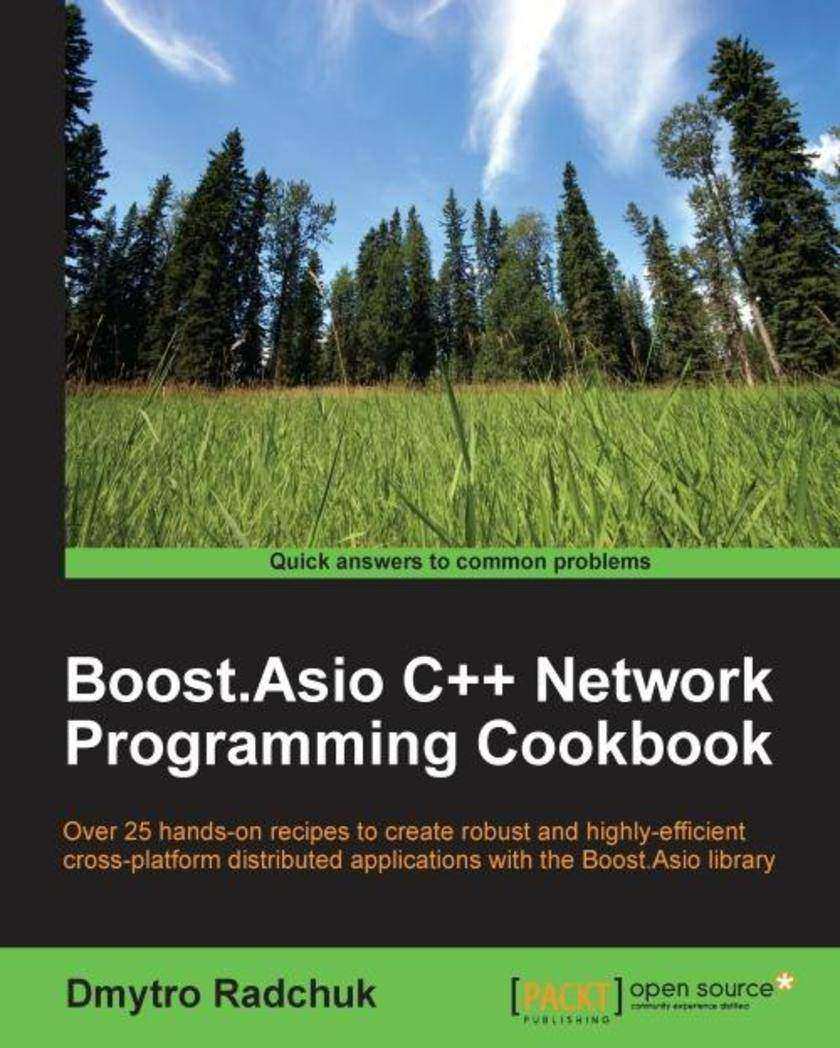
Boost.Asio C++ Network Programming Cookbook
¥90.46
Over 25 hands-on recipes to create robust and highly-efficient cross-platform distributed applications with the Boost.Asio libraryAbout This BookBuild highly efficient distributed applications with easeEnhance your cross-platform network programming skills with one of the most reputable C++ librariesFind solutions to real-world problems related to network programming with ready-to-use recipes using this detailed and practical handbookWho This Book Is ForIf you want to enhance your C++ network programming skills using the Boost.Asio library and understand the theory behind development of distributed applications, this book is just what you need. The prerequisite for this book is experience with general C++11. To get the most from the book and comprehend advanced topics, you will need some background experience in multithreading.What You Will LearnBoost your working knowledge of one of the most reputable C++ networking libraries—Boost.AsioFamiliarize yourself with the basics of TCP and UDP protocolsCreate scalable and highly-efficient client and server applicationsUnderstand the theory behind development of distributed applicationsIncrease the security of your distributed applications by adding SSL supportImplement a HTTP client easilyUse iostreams, scatter-gather buffers, and timersIn DetailStarting with recipes demonstrating the execution of basic Boost.Asio operations, the book goes on to provide ready-to-use implementations of client and server applications from simple synchronous ones to powerful multithreaded scalable solutions. Finally, you are presented with advanced topics such as implementing a chat application, implementing an HTTP client, and adding SSL support. All the samples presented in the book are ready to be used in real projects just out of the box.As well as excellent practical examples, the book also includes extended supportive theoretical material on distributed application design and construction.Style and approachThis book is a set of recipes, each containing the statement and de*ion of a particular practical problem followed by code sample providing the solution to the problem and detailed step-by-step explanation. Recipes are grouped by topic into chapters and ordered by the level of complexity from basic to advanced.




 购物车
购物车 个人中心
个人中心



